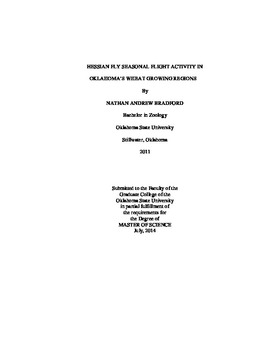| dc.contributor.advisor | Giles, Kristopher L. | |
| dc.contributor.author | Bradford, Nathan Andrew | |
| dc.date.accessioned | 2015-06-17T20:04:58Z | |
| dc.date.available | 2015-06-17T20:04:58Z | |
| dc.date.issued | 2014-07-01 | |
| dc.identifier.uri | https://hdl.handle.net/11244/14737 | |
| dc.description.abstract | Wheat is the most economically important food crop grown in Oklahoma. The Hessian fly is a common pest in wheat in all of the wheat production zones of North America. The Hessian fly was first recorded coming into the United States in the 18th century and Hessian mercenaries were blamed for the introduction as they may have brought the insect over in their straw bedding materials. Their introduction, however, can be linked to numerous introductions at multiple locations within the United States. When Hessian fly populations within a field exceed approximately 1 per tiller, the infestation is considered damaging and above the economic injury level. Such Infestations warrant the use of population control measures. The most effective way of controlling Hessian fly populations is through the sowing of resistant wheat cultivars. Insecticides, late-planting, and crop rotation are included in the Hessian fly control measures amongst other methods. Little is known about the flight patterns of Hessian fly over time in Oklahoma's wheat growing regions. A state wide survey was conducted attempting to characterize seasonal flight patterns of the Hessian fly in Oklahoma. Another objective of this research was to correlate observed flight activity with statewide weather patterns. Understanding the yearly trends in flight patterns could allow producers to better time their use of control measures. Sticky traps accompanied with PheroNet� (PheroNet, Alnarp, Sweden) Hessian fly pheromone lures were placed in wheat fields and pastures statewide and sampled year round for two growing seasons (2011/2012 and 2012/13). The numbers of Hessian fly per trap were recorded and compared with weather patterns such as precipitation and temperature. There were two discrete flight episodes observed during both growing seasons that were flanked by periods void of observable flight. One small fall flight period and one prolonged spring flight period were recorded and there was no flight observed at most locations during the extreme summer or winter months. These findings can help Oklahoma wheat producers correctly time Hessian fly control measures to coincide with the most effective periods when Hessian fly are susceptible to control methods. | |
| dc.format | application/pdf | |
| dc.language | en_US | |
| dc.publisher | Oklahoma State University | |
| dc.rights | Copyright is held by the author who has granted the Oklahoma State University Library the non-exclusive right to share this material in its institutional repository. Contact Digital Library Services at lib-dls@okstate.edu or 405-744-9161 for the permission policy on the use, reproduction or distribution of this material. | |
| dc.title | Hessian Fly Seasonal Flight in Oklahoma's Wheat Growing Regions | |
| dc.type | text | |
| dc.contributor.committeeMember | Royer, Tom A. | |
| dc.contributor.committeeMember | Elliott, Norman C. | |
| osu.filename | Bradford_okstate_0664M_13534.pdf | |
| osu.accesstype | Open Access | |
| dc.description.department | Entomology | |
| dc.type.genre | Thesis | |
| dc.subject.keywords | cecidomyiidae | |
| dc.subject.keywords | flight | |
| dc.subject.keywords | fly | |
| dc.subject.keywords | hessian | |
| dc.subject.keywords | pheromone | |
| dc.subject.keywords | wheat | |
